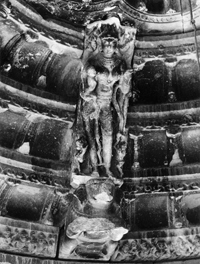Sitalesvara Jhalawad Gauri-Sankara Theft

This information is about the theft of a Gauri-Shankara sculpture from the Shitaleshvara Mahadeva temple on the bank of the River Chandrabhaga at Jhalrapatan in district Jhalawad, Rajasthan. The Shitaleshvara Mahadeva temple is an important early archaeological monument, dated by an inscription to 689 AD. While the original temple was built at the end of the seventh century, a Mandapa with a row of columns was added to it in the early tenth century. Probably at that time, a sculpture of Gauri-Shankara, also known as Shiva-Parvati, illustrated in the accompanying photograph, was installed in the sanctum, which originally must have had Shiva’s Linga as the central image for worship. The temple, and the other structures at the site, are under the protection of the Jaipur Circle of theArchaeological Survey of India (ASI).
The circumstances of the theft were as follows: “Deva Prabodhini Ekadashi”, eleventh day in the Hindu month of Kartika, a day sacred to the Hindus, fell on 23 November 2012, when an annual religious fair was held at this place, lasting a few days, when the attending pilgrims bathed in the Chandrabhaga. Gauri-Shankara was stolen during the night of 26/27 November 2012 by four unknown men dressed as Sadhus who offered food mixed with some sleep-inducing substance to the priest and the ASI staff on duty, then broke open the shrine door.
The divine couple seated on the sacred bull mount are in a close embrace, Shiva’s four hands bearing his trident, a flower, a cobra and clasping the waist of his consort; Gauri or Parvati carrying a mirror in her hand and holding Shiva with her other hands. Their two sons Ganesha and Kartikeya, and other attendants, are besides them, and a demon under the threshold tries to dislodge them. Figures of the Mother goddesses are ranged above.
The theft was recorded at the Jhalrapatan Police Station under First Information Report (FIR) No. 248 on 27 November 2012 (“Pravishti” No. 1242).
This intimation is to alert all scholars, museums, collectors, dealers etc. that the sculpture illustrated here is stolen property of the government of India. The Shitaleshvar temple is a monument of National importance as declared by the Archaeological Survey of India. The sculpture’s theft is on record with the police, its photographs exist in the ASI’s archives, and the sculpture is now being illustrated here for public knowledge. Therefore, if anyone acquires this stolen heritage, he will not be able to enjoy his possession and will always be obliged to conceal it.
If any museum, private collector or dealer has acquired this sculpture, they are advised to relinquish possession at once, inform either INTERPOL, or the ASI in New Delhi or Jaipur, whose addresses are on the website www.asi.nic.in, or their local police authorities. If anyone has received this piece even in innocence, he knows now that it is a stolen and possibly illegally exported antiquity protected under the Indian laws, which forbid such acts.
In the past, smuggled antiquities could be traced through their publication on www.plunderedpast.in, with the support of conscientious scholars and individuals: see the Fresh Updates about the two amorous couples from Rajasthan, and a Brahma-Brahmani from Gujarat.
The photograph published here is courtesy of the American Institute of Indian Studies, Accession No. is 81317 (dsal.uchicago.edu).
Bibliography: This theft is mentioned in the Post Script to K. L. Mankodi, “Śītalā, and Śiva as ‘Śītaleśvara’, on the Chandrabhaga’s Tīrtha at Jhalrapatan”, Berliner Indologische Studien 24, 2019, p. 187 (the entire article, pp. 165-190).



























